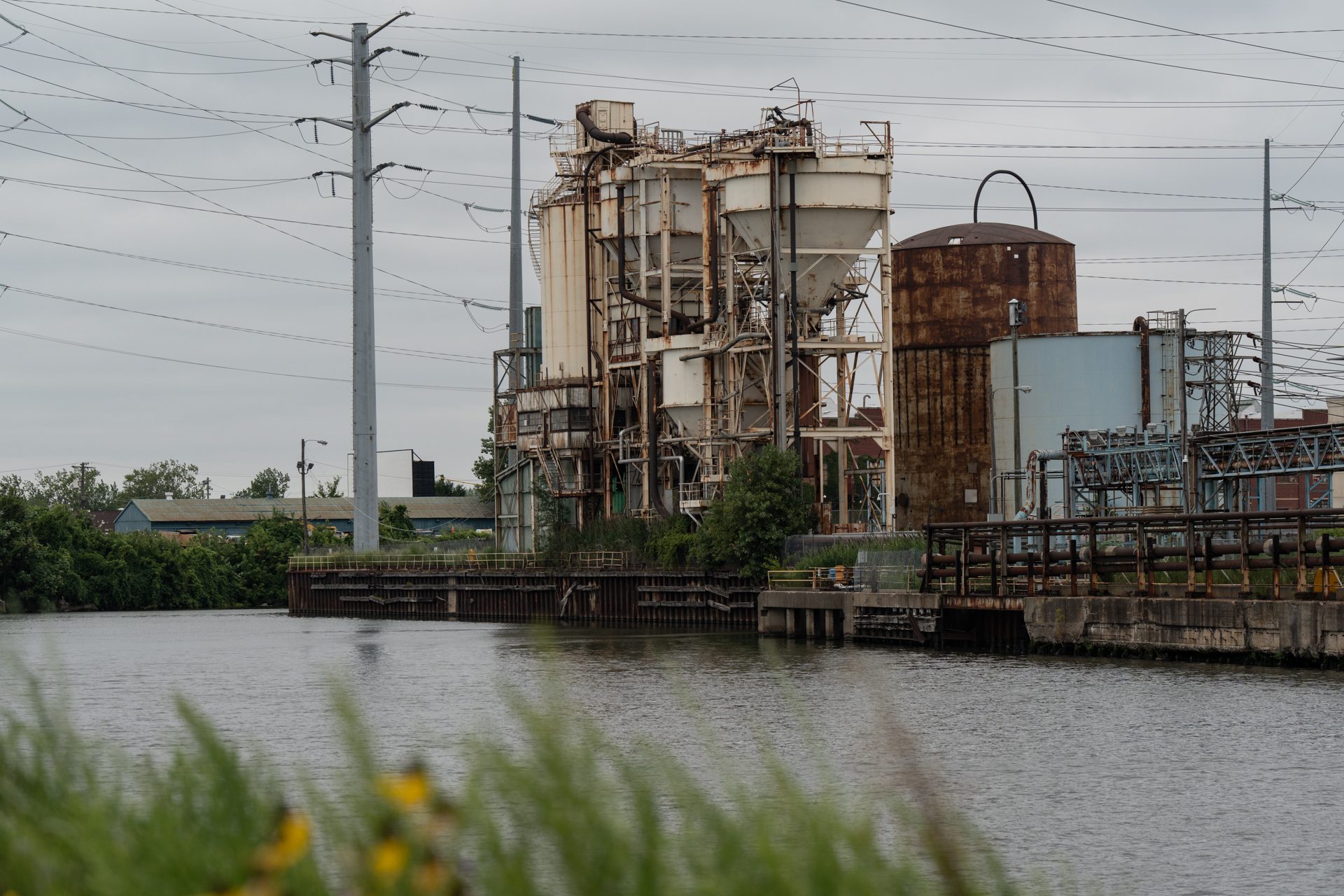 Max Herman/Borderless Magazine
Max Herman/Borderless MagazineAs Midwest Generation Fisk Station owners move to remove a cracked and leaning silo at the site, residents called for high-quality air monitors and more communication from the city about the demolition process.
As the city prepares to greenlight a partial demolition at the Midwest Generation Fisk Station, Pilsen and Little Village residents raise concerns about the upcoming work, citing the botched implosion of the Crawford coal plant four years ago.
During a recent community meeting at Dvorak Park, city officials from the Chicago Department of Buildings and Chicago Department of Public Health laid out plans to remove a structure at the Fisk Station, located in Pilsen’s Industrial Corridor.
Under the demolition plan, city officials and contractors assured residents no implosion would be carried out at the coal plant that was retired amid pressure and health concerns from activists in 2012.
Want to receive stories like this in your inbox every week?
Sign up for our free newsletter.

The Department of Buildings has not issued a permit for the demolition. Officials said the work could begin this month and take about two weeks to complete, but the exact date has yet to be determined. The Department of Public Health has not confirmed how far in advance they would notify nearby residents prior to the start of the demolition.
Brandenburg Industrial Service Company, the company contracted to carry out the demolition, would only be removing a silo that is 60 feet tall and 40 feet wide in diameter, said Drew Deichmann, project manager at Brandenburg.
The structure, built in 1958, was used to store coal fly ash, a byproduct of coal combustion in the form of a very fine, powdery material composed mostly of silica. A routine inspection found the silo was leaning and had developed a crack, which prompted the move to take it down, according to Buildings Commissioner Marlene Hopkins.
During the meeting, attendees from Pilsen and neighboring Little Village asked for more communication from the city about the procedure with residents in the area. They asked for details about what air monitors would be used and additional information on the process to ensure no debris flies into the air or runs off to the nearby waterway. They also asked tobe notified as soon as something goes awry.
Public Health Commissioner Olusimbo Ige and other panelists assured residents there would be no implosion. The city labeled the demolition of the structure as “environmentally complex” due to its proximity to the Chicago River and the facility’s prior use, coal power generation, she said.

While the site on 1111 W. Cermak Road is retired, some features are still active, with transmission lines and a peaking plant connected to the grid that provides energy to the City of Chicago when needed, said Phillip Raush, a plant manager at the Fisk station.
Deichmann said the process will involve cutting down and removing pieces of the tank until only a concrete slab that sits as the foundation of the silo remains. The pieces will be loaded onto trucks and transported out of the site.
Officials said water would be used to hose down dust that could come up during the process, and all fly ash and most of the asbestos in the tank had already been removed. Officials said four air monitors would be on-site, reporting data at 15-minute intervals, but did not specify the type of monitors when asked by residents.
Ige said inspectors from the Chicago Department of Buildings and the Chicago Department of Public Health will be onsite before the demolition to ensure controls are in place and during the process to observe and be able to halt the process and address issues as they arise.
Read More of Our Coverage
The community meeting came a day after Department of Buildings Commissioner Marlene Hopkins and Chief Sustainability Officer Angela Tovarmet met with Little Village residents at Little Village Lawndale High School. Some attendees continued to express frustration over the city’s handling of the implosion of the Crawford coal plant in 2020, which resulted in a plume of dust covering nearby homes amid the COVID-19 pandemic.
In 2022, a leaked inspector general report stated that Hopkins was one of three city officials to blame for the city’s failure to oversee the implosion and recommended disciplinary action. She was the first deputy commissioner of the Department of Buildings.
In March, Chicago Mayor Brandon Johnson appointed Hopkins to lead the Department of Buildings. The decision was met with disappointment by some Little Village residents, who continue to express concern about the city’s handling of the 2020 and future demolitions.
At the Little Village meeting, Hopkins faulted the contractor and city health officials for the lingering dust that spread into nearby homes and assured them that changes had been made to the oversight process to ensure it wouldn’t happen again.
“That’s great; It’s not going to happen again, but it happened, and so this neighborhood becomes the guinea pig,” Lucky Camargo, a Little Village resident, told Hopkins on Wednesday. “I feel an injustice, and it hasn’t been rectified.”
Kim Wasserman, executive director of the Little Village Environmental Organization, expressed her disappointment in Ige’s not attending the Little Village meeting the night before.
“These communities, even though they’re separated by Western [Avenue], still have a lot of ties to each other,” Wasserman told Ige at the Fisk demolition meeting. “How are we supposed to trust you, in particular your department, when you can’t even be bothered to come to show your face?”
Ige apologized for missing the meeting due to a media interview about COVID-19 and said she hopes to “stay in conversation to walk through the hurt and the trauma of the past.”
Residents can learn more about the demolition process by visiting this website.
Correction 08/14/2024: An earlier version of this article incorrectly stated Department of Buildings Commissioner Marlene Hopkins was the first deputy commissioner in the Public Health Department during the Hilco Implosion. She was the first deputy commissioner of the Department of Buildings at the time.
Aydali Campa is a Report for America corps member and covers environmental justice and immigrant communities for Borderless Magazine. Send her an email at [email protected]

Bring power to immigrant voices!
Our work is made possible thanks to donations from people like you. Support high-quality reporting by making a tax-deductible donation today.

